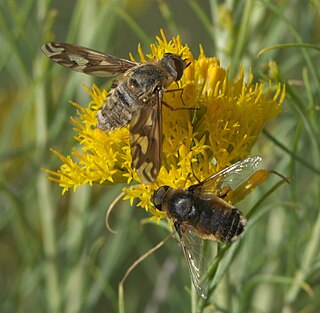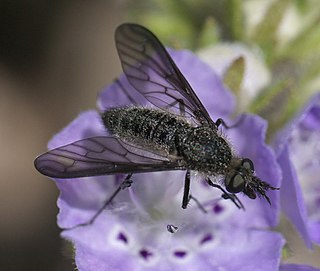
The Bombyliidae are a family of flies, commonly known as bee flies. Some are colloquially known as bomber flies. Adults generally feed on nectar and pollen, some being important pollinators. Larvae are mostly parasitoids of other insects.

Poecilanthrax willistonii, Williston's bee fly or sand dune bee fly, is a member of the Bombyliidae insect family. This family includes the bee flies, true flies that have developed Batesian mimicry characteristics to avoid predators. That is, they look like bees because that helps them avoid bee-wary predators, but they lack stingers.

Conophorini is a tribe of bee flies in the family Bombyliidae.
Exoprosopa parda is a species of bee fly in the family Bombyliidae.
Aldrichia auripuncta is a species of bee fly in the family Bombyliidae. It is found in the northeastern United States.

Aldrichia is a North American genus of bee flies in the family Bombyliidae. The genus contains two described species.

Geron is a genus of bee flies in the family Bombyliidae. There are at least 180 described species in the genus Geron, found on every continent except Antarctica.
Systropus angulatus is a species of bee fly in the family Bombyliidae. It is found in Texas.
Poecilanthrax nigripennis is a species of bee fly in the family Bombyliidae.
Bombylius atriceps is a species of bee flies in the family Bombyliidae.
Paravilla aridula is a species of bee fly in the family Bombyliidae. It is found in Arizona and California.
Ogcodocera leucoprocta is a species of bee fly in the family Bombyliidae. It is found in Mexico and north through the eastern United States to Quebec.
Paradiplocampta is a genus of bee flies in the family Bombyliidae. There is one described species in the genus Paradiplocampta, P. tabeti, known from California and Arizona.

Exoprosopa jonesi is a species of bee fly in the family Bombyliidae.
Paravilla californica is a species of bee fly in the family Bombyliidae. It is found in the southwestern United States and northwestern Mexico.
Hemipenthes inops is a species of bee fly in the family Bombyliidae. It is found in the western United States. It is somewhat unusual compared to other members of the genus Hemipenthes in that its wings are mostly transparent.
Paravilla cinerea is a species of bee fly in the family Bombyliidae. It is found in Arizona and Baja California Norte.
Bombylius curtirhynchus is a species of bee flies in the family Bombyliidae.
Lepidanthrax arnaudi is a species of bee fly in the family Bombyliidae. It is found in California.
Exoprosopa eremita is a species of bee fly in the family Bombyliidae. It occurs in western North America.





